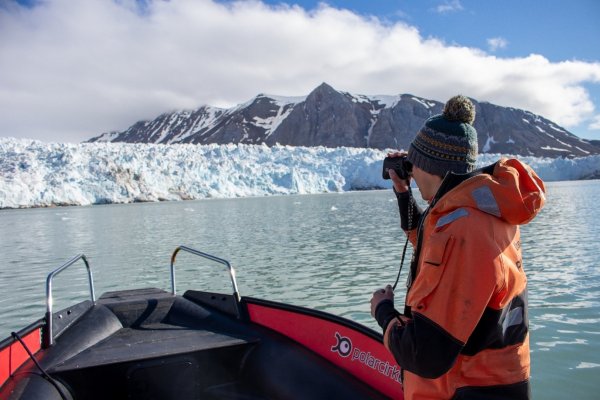The project “Spatio-temporal variability of two contrasting sediment-laden meltwater plume systems, Kongsfjorden, Svalbard” received funding from the SIOS Access Programme to undertake fieldwork in the summer of 2021.

After much questioning about whether a field season would be possible because of COVID-19 travel restrictions in the UK, mainland Norway and Svalbard, a team of two researchers from Loughborough University made it to Ny-Ålesund for a long awaited field season. This project was hosted by Norwegian Polar Institute, Sverdrup and made possible by Kings Bay’s boat drivers Kennet and Erlend who offered a lot of their time and expertise to support data collection.
The fieldwork was conducted between the 17 June – 12 July at two locations in the Kongsfjorden region close to Ny-Ålesund: the Bayelva river outlet and along the Blomstrandbreen calving front. The early phase of the fieldwork coincided with cooler temperatures, but snow melt, and the latter phase a more consistent melt due to increasingly positive temperatures at the peak of the summer season in the Kongsfjorden region.
Activities that were undertaken in the field included:
- Regular measurements of surface reflectance at the Bayelva river and Blomstrandbreen sediment-laden plumes
- Collection of surface water samples to determine suspended sediment concentration
- Conductivity, Temperature, Depth (CTD) measurements within, at the periphery and outside the sediment-laden plumes
Aerial photography data has been collected by NORCE for this project to understand the dynamic behaviour of plumes over short timescales (sub-daily – daily) without the impacts of cloud cover.
The data collected during this field season add to previous datasets from the Bayelva river plume collected in 2012 and 2019, and at the Blomstrandbreen plume in 2019. The aim of gathering multiple datasets is to better understand the volumes of sediment and water entering Kongsfjorden and whether this is changing as a result of glacier recession and extended melt seasons. Sediment-laden meltwater plumes also act as a great proxy for hydrological activity of glaciers and we aim to use the data collected in 2021 along with previous datasets to undertake cal/val of various satellite platforms which we believe will make this type of research viable in a remote setting, alleviating the environmental impact on Svalbard and other polar regions.
At present there is a considerable amount of data analysis still to complete, but we are looking forward to sharing the results with the SIOS community, and beyond.
The project team are very grateful to SIOS for their funding and assistance in making the field season happen in these difficult times.

Photos: (1) Measuring the distance from the Polarcirkel to the Blomstrandbreen calving front on a rare sunny day in Kongsfjorden (top). (2) Priming the hand-held spectroradiometer to take reflectance measurements at the Bayelva (also known as Red) River close to Nilsebu, with Austre and Vestre Brøggerbreen forefields in the background (bottom). Pictures courtesy of Jonathan Slessor (project field assistant).



























